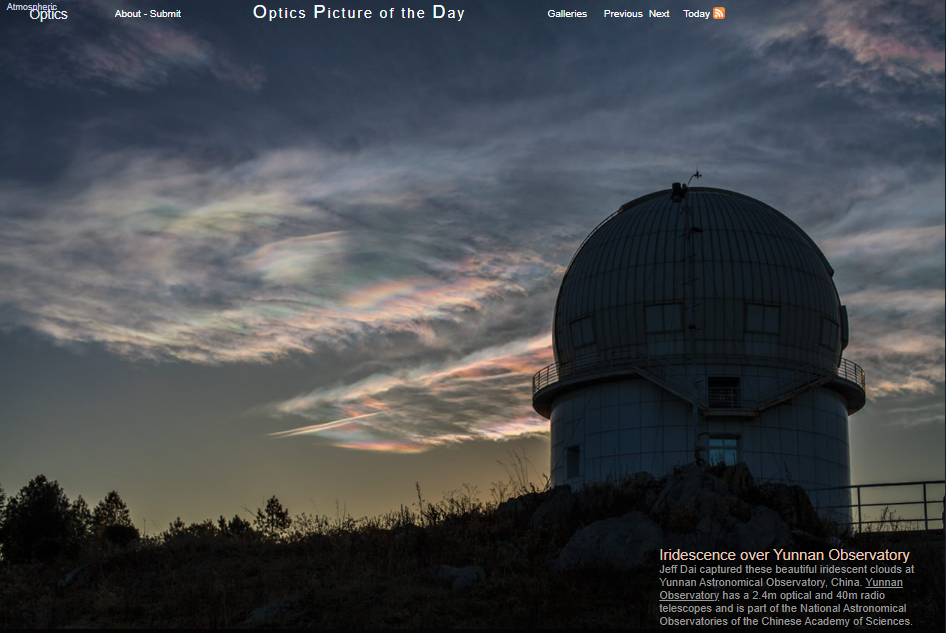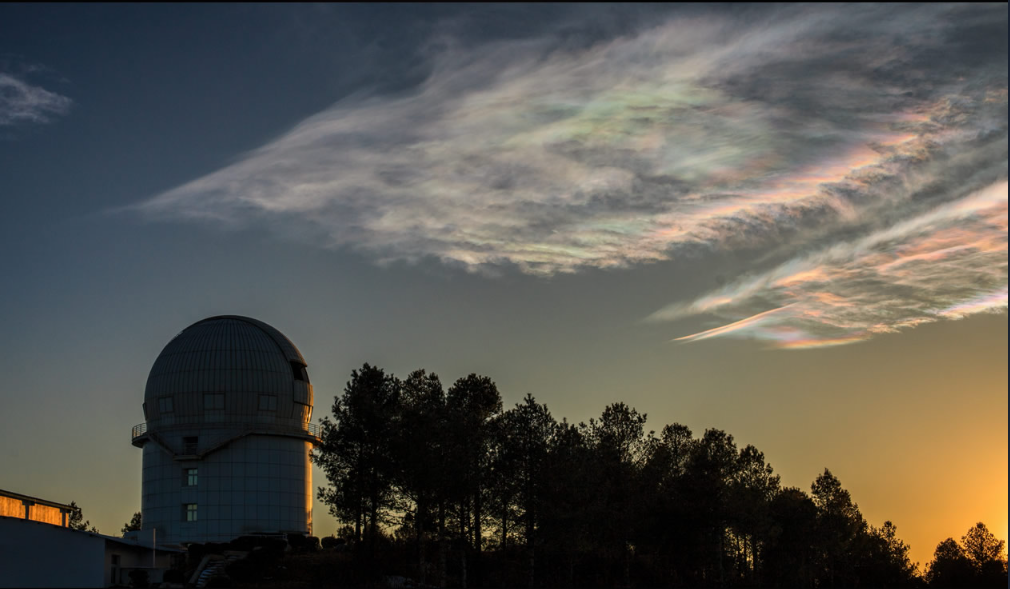Iridescence, Yunnan Observatory, China - OPOD
Iridescence: A Mesmerizing Phenomenon at Yunnan Observatory, China
At the Yunnan Astronomical Observatory in China, photographer Jeff Dai captured a stunning display of iridescent clouds. These captivating formations add a touch of magic to the already remarkable setting of the observatory. The Yunnan Observatory, which houses a 2.4m optical telescope and a 40m radio telescope, is an essential part of the National Astronomical Observatories of the Chinese Academy of Sciences.
Iridescence occurs when individual water droplets within the clouds scatter sunlight, particularly from their outer skin. Each point on the droplet's surface acts as a source of outgoing spherical waves. As these waves overlap and interfere with each other, they create variations in brightness and darkness. The resulting interference patterns are wavelength dependent and produce an array of colors.
If the cloud consists of uniform-sized droplets, it would create a corona effect. However, when the droplet sizes vary across the cloud, the result is a more chaotic and disordered display of colors, commonly referred to as iridescence. This phenomenon adds an extra layer of beauty to the already awe-inspiring sight at Yunnan Observatory.
Iridescence is a captivating atmospheric optics phenomenon that has fascinated scientists and observers alike for centuries. Let's delve deeper into this mesmerizing display and explore its underlying mechanisms:
-
Scattering of Sunlight: The scattering of sunlight by water droplets is the primary mechanism behind iridescence. As sunlight passes through the atmosphere, it encounters these tiny droplets suspended in the clouds. The droplets scatter the sunlight in various directions, contributing to the vibrant display of colors.
-
Interference Patterns: When spherical waves from different droplets overlap and interfere with each other, they create intricate interference patterns. These patterns determine the distribution of brightness and darkness, resulting in the mesmerizing iridescent colors we observe.
-
Wavelength Dependence: The interference patterns formed by the overlapping waves are wavelength dependent. Different wavelengths of light, such as red, blue, and green, interact differently with the droplets, leading to the colorful spectrum of iridescence.
-
Droplet Size Variation: The size variation of water droplets within the cloud plays a crucial role in the appearance of iridescence. When droplets of different sizes are present, the scattering and interference patterns become more complex, resulting in a more disordered and vibrant display of colors.
-
Natural Optical Phenomenon: Iridescence is a natural optical phenomenon that can occur in various atmospheric conditions. It is often observed in thin clouds, such as cirrus clouds, where the droplets are more likely to be of varying sizes.
-
Similarity to Rainbow Colors: Iridescence shares some similarities with the colors of a rainbow. However, while rainbows are caused by the refraction and reflection of sunlight by raindrops, iridescence is primarily a result of scattering and interference within water droplets.
-
Enhancing Natural Beauty: The presence of iridescence adds an ethereal and enchanting quality to the already breathtaking surroundings of the Yunnan Observatory. It serves as a reminder of the intricate and awe-inspiring nature of our atmosphere.
-
Photographic Challenges: Capturing the full glory of iridescence through photography can be challenging. The dynamic nature of the phenomenon, coupled with its dependence on lighting conditions and droplet sizes, requires skilled photographers like Jeff Dai to seize the perfect moment and composition.
-
Scientific Significance: While iridescence is a visually stunning phenomenon, it also holds scientific significance. Studying the patterns and characteristics of iridescence can provide valuable insights into the properties of atmospheric particles, such as droplet size distribution and optical properties.
-
Appreciating Nature's Artistry: Iridescence at Yunnan Observatory serves as a reminder of the wonders that can be found within our natural world. It invites us to pause, appreciate, and marvel at the intricate interplay of light, water, and atmosphere that creates such breathtaking displays.
In conclusion, the iridescence captured at Yunnan Observatory in China is a truly captivating sight. It showcases the beauty and complexity of atmospheric optics, reminding us of the remarkable phenomena that surround us. Through the interplay of sunlight, water droplets, and interference patterns, iridescence adds a touch of magic to the already awe-inspiring setting of the observatory. Let us continue to appreciate and explore the wonders of our atmosphere, as they never cease to amaze us with their splendor.

Iridescence over Yunnan Observatory
Jeff Dai captured these beautiful iridescent clouds at Yunnan Astronomical Observatory, China. Yunnan Observatory has a 2.4m optical and 40m radio telescopes and is part of the National Astronomical Observatories of the Chinese Academy of Sciences.
All images ©Jeff Dai, shown with permission

Individual water droplets in the clouds scatter sunlight, mainly from their outer skin.
Each point on the skin is effectively a source of outgoing spherical waves. The waves overlap and interfere to give brightness in some directions and darkness in others. The interference is wavelength dependent and the scattering or diffraction pattern is coloured.
A cloud of uniform sized droplets would give a corona. When the droplet size varies across the cloud we see more disordered colours - iridescence.

Note: this article has been automatically converted from the old site and may not appear as intended. You can find the original article here.
Reference Atmospheric Optics
If you use any of the definitions, information, or data presented on Atmospheric Optics, please copy the link or reference below to properly credit us as the reference source. Thank you!
-
<a href="https://atoptics.co.uk/blog/iridescence-yunnan-observatory-china-opod/">Iridescence, Yunnan Observatory, China - OPOD</a>
-
"Iridescence, Yunnan Observatory, China - OPOD". Atmospheric Optics. Accessed on April 19, 2024. https://atoptics.co.uk/blog/iridescence-yunnan-observatory-china-opod/.
-
"Iridescence, Yunnan Observatory, China - OPOD". Atmospheric Optics, https://atoptics.co.uk/blog/iridescence-yunnan-observatory-china-opod/. Accessed 19 April, 2024
-
Iridescence, Yunnan Observatory, China - OPOD. Atmospheric Optics. Retrieved from https://atoptics.co.uk/blog/iridescence-yunnan-observatory-china-opod/.